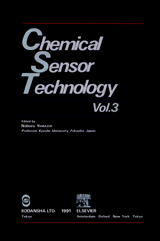Chemical Sensor Technology, Vol. 3

内容紹介
<英文書>
ガスセンサ、バイオセンサ、イオンセンサなど化学センサの基礎、実用化、応用に関する最新の先導的研究を集録。国際的に精選された第一線の研究者が、新技術の展開のみならず研究思想や方法論にも言及。信頼性の高い情報を提供する最新のシリーズ第3巻。海外提携先:Elsevier B.V.
目次
Gas-Sensing Characteristics of Oxide Whiskers
1. Introduction
2. Morphology of Whiskers and Sensor Element
3. Gas-Sensing Characteristics of As-Grown Whiskers
4. Influence of Surface Treatment on Gas Sensitivity
5. Effect of Foreign Ion Doping on Gas Sensitivity
6. Summary and Conclusion
Tin Dioxide Gas Sensor -- New Approach to Odor Sensing
1. Introduction
2. Current Research on Odor Sensing
3. A High Sensitive, Low Power-Consuming SnO2 Gas Sensor for Volatile Sulfides
4. Odor Sensor Application for Dentistry
5. Conclusion
Theory and Practice of Dielectric-Supported Thin Film Chemiresistors
1. Introduction
2. Chemiresistor Fabrication
3. Instrumentation
4. Chemiresistor Characteristics
5. Conclusion
Multicomponent Analysis in Chemical Sensing
1. Introduction
2. Multicomponent Analysis and Pattern Recognition : Definitions from Analytical Chemistry
3. Measuring Signals for Chemical Sensing
4. Examples for Single Component Analysis
5. Examples for Multicomponent Analysis
6. Outlook
Automotive Oxygen Sensors
1. Introduction
2. Types of Automotive Oxygen Sensors
3. Behavior of Automotive Oxygen Sensors
4. Engine Control
5. Other Automotive Uses of Oxygen Sensors
6. Concluding Remarks
Principles and Fabrication Materials of Electrochemical Sensors
1. Principles and Modes of Operation of Electrochemical Sensors
2. Fabrication of Electrochemical Sensors
3. Fabrication Materials
Use of High Temperature Proton Conductor for Gas Sensors
1. Introduction
2. Principles of Concentration Cell Type Hydrogen and Steam Sensors
3. Proton Conductor Applicable for High Temperature Gas Sensors
4. Properties of SrCeO3 and BaCeO3-Based Ceramics
5. Structure of Sensors
6. Hydrogen Sensor
7. Steam Sensor
8. Hydrogen and Steam Sensors Using a Solid Standard Material
9. Conclusion
Development of an SOx Sensor Based on Metal Sulfates
1. Research Background
2. The Principle of SO2 Detection with an Alkali Metal Sulfate-Based Solid Electrolyte
3. SO2 Gas Sensing with an Alkali Metal Sulfate-Based Electrolyte
4. Recent SO2 Gas Sensor Developments with a Solid Electrolyte/Metal Sulfate Couple
5. Future Perspectives
Polymer-Based Capacitive Hygrometers
1. Introduction
2. The Basic Principle of the Polymer-Based Capacitive Hygrometer (PBCH)
3. Comparison with Other Means of Humidity Measurement
4. Manufacturing Technologies of PBCH
5. Test Procedure for Sensors Characterization
6. Typical Behavior of a PBCH
7. Improvement of the Sensor's Performance by Changing the Polymer
8. The State of the Art at an Industrial Level
9. Conclusion
Development and Applications of Fiber Optic Sensors
1. Introduction
2. Fiber-Optic Sensors (Optrodes)
3. Fiber-Optic Spectroscopy
4. Field Applications of Fiber-Optic Sensors
5. Conclusions
In-situ Fiber Optic Sensing Technique for Chemical Composition and Temperature of Gas at Elevated Temperatures by Infrared Spectroscopy
1. Introduction
2. Principle of Measurement, Vibrational-Rotational Spectrum
3. Experimental Technique
4. Quantitative Analysis of CO, CO2 and H2O
5. Temperature Determination of Gas at Elevated Temperatures
6. Examples of Application
7. Conclusion
The Development and Scope of Ion-Selective Electrodes
1. Early Stages
2. Progress and Some Fundamentals
3. PVC Matrix Membrane Electrodes
4. Selectivity Matters
5. Ion-Selective Field Effect Transistors (ISFETs)
6. Utilization of Ion-Selectivc Electrodes
7. Liquid Ion-Exchanger Type Sensors
8. Crown Ethers and Other Neutral Carrier Sensors
9. Conclusion
Microstructured ISFETs
1. Introduction
2. pH-ISFETs with Back-Side Contacts
3. Multi-Ion Sensing System Based on Glass-Encapsulated pH ISFETs
4. Conclusion
Interfacial Electrochemistry of Flavoenzymes and Its Potential Application to the Preparation of a New Enzyme Sensor
1. Introduction
2. Experimental
3. Results and Discussion
4. Future Prospects
5. Summary
Microvoltammetry and Brain Dialysis
1. Introduction
2. Microdialysis
3. Voltammetry at Microelectrodes
4. Comparison of Voltammetry and Microdialysis as in vivo Sensors
5. Complementary Use of Voltammetry and Microdialysis
Ultramicroelectrodes as Sensing Devices for Biological Molecules
1. Introduction
2. Sensing with Ultramicrodisk (Ultramicroring) Electrodes
3. Flow Analyses Using Microarray Electrodes
Recent Development of lmmunochemical Sensors and Immunological Assays Using Monoclonal Antibodies Against Small Molecules
1. Introduction
2. Experimental
3. Method of Immunological Analysis
4. Present and Future Development of Immunochemical Sensors